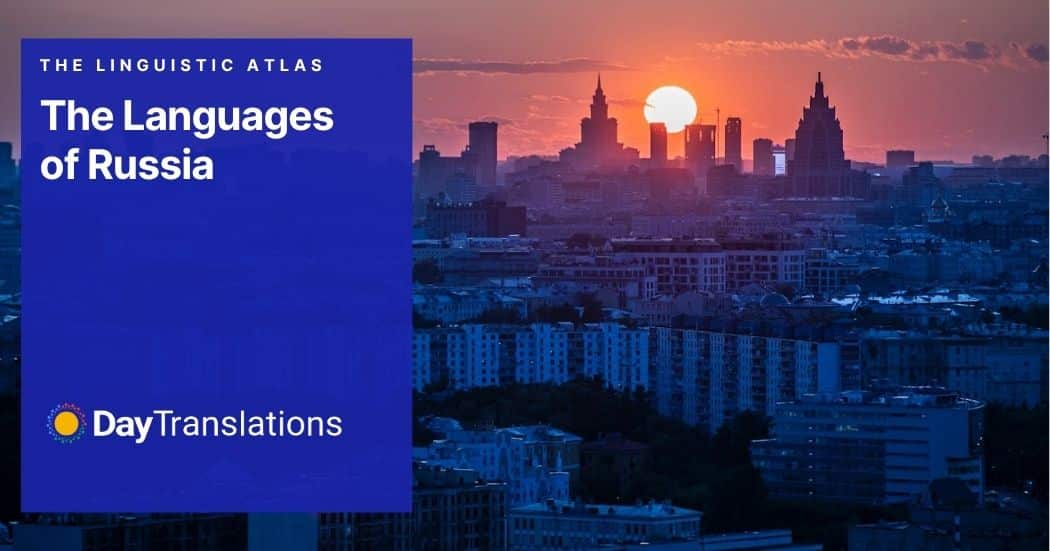Russia is the largest country in the world, and the ninth most populous country. With a population of just over 143 million citizens, Russia is a diverse amalgam of various cultural and linguistic features. This is more than obvious when we look at the languages of Russia. If we sum up all the minority languages, together with the official languages of Russia, it’s more than 100 languages and dialects. While it’s far behind the 839 languages of Papua New Guinea, the Russian language community is one of the most colourful ones in the world.
The Official Languages of Russia
When talking about the languages spoken in Russia, it’s important to highlight that the Russian language is the only official language at the national level. Russia consists of 22 republics, each with its own local people and languages, in addition to Russian. Russian is the official language in each of these federal units, as well, but every republic also has its own official language. In line with that, there are 35 official local languages, spoken by smaller ethnic communities living in those Russian republics.
Turkic languages in Russia
For instance, the Tatar language is the second most common language spoken in Russia, mostly limited to the Republic of Tatarstan. Some 5.5 million citizens of the Russian Federation are native Tatar speakers. A Turkic language by origin, Tatar has its own way of writing letters, with the Latin alphabet as its base; unlike some other languages in Russia, which are based on the Cyrillic alphabet.
The citizens of the Chuvash Republic speak Chuvash – another Turkic language by its origin. To be more precise, some 1.6 million Chuvash people use this language for their daily communication.
When talking about the Turkic-originating languages of Russia, it’s important to mention Bashkir, spoken in the Republic of Bashkortostan by around 1.5 million speakers. Although having Turkish origins, this language relies on the Cyrillic script.
Northeast Caucasian Languages
Chechnya is a federal Russian republic in the northern part of the Caucasus Mountains. Logically, the language spoken in this region is called Chechen, and around 1.4 million people speak Chechen as their native language.
Two more non-Slavic languages that surpass 1 million speakers in Russia are Armenian and Avar.
Avar is another language limited to the northeast Caucasian Mountains. Some 1.1 million citizens of the federal Republic of Dagestan speak Avar. Just like Chechen, Bashkir, Chuvash, Tatar, and the other official languages of Russia, it’s vital for preserving the ethnic and cultural identity of its people.
On the other hand, approximately 1.1 million members of the Armenian minority in Russia speak Armenian. Most of its speakers are concentrated in larger cities, like Krasnodar and Moscow.
Slavic Languages in Russia
Ukrainian is the most widespread Slavic language in Russia, besides the Russian language. Between 600,000 and 1 million citizens of Russia speak Ukrainian. These are mostly members of the Ukrainian minority, predominantly in the regions bordering Ukraine in the west. Although it’s not as large as Tatar or Bashkir, the Ukrainian language plays a vital role in the cultural and historical development of western Russia.
On the other hand, around 300,000 citizens of Russia speak Belarusian. Those are mostly members of the Belarusian ethnic minority, mostly concentrated in the regions bordering Belarus.
Countries That Speak Russian
The Russian language isn’t limited only to the Russian Federation. As a matter of fact, Russia is surrounded by several Russian-speaking countries, such as Kazakhstan, Belarus, Ukraine, Moldova, and Uzbekistan. Basically, Russian has remained a widely spoken language in the Commonwealth of Independent States – a group formed by Russia and 11 other former Soviet states, after the dissolution of the Soviet Union.
When it comes to exact figures, Kazakhstan currently hosts more than 3.7 million native Russian speakers. In Belarus, there are approximately 6.6 million speakers of the Russian language. Finally, there are between 11 and 14 million native Russian speakers in Ukraine.
However, absolute figures might not show the precise share of the Russian speakers in the countries that speak Russian. For instance, only 700,000 people speak Russian as their mother tongue in Latvia. But in that small Baltic country, this amounts to 34% of the total population. Similarly, the Russian language is spoken by approximately 380,000 people in Estonia, which makes almost 30% of the Estonian population. And yet, the 700,000 speakers of the Russian language in Uzbekistan make up only 2% of its population.
The History Behind the Russian Language
The Russian Empire used to spread from Central Europe to the Pacific Ocean. The influence of the USSR covered a similar area. When we know that the Russian language was the lingua franca of both those countries, it becomes a bit clearer why there are so many Russian-speaking countries from Minsk to Dushanbe.
At the same time, as Russian political, cultural, and linguistic influence was spreading, it came in contact with various local languages and ethnic groups. During the period of the Russian Empire, there weren’t too many concessions to local languages and peoples. However, the formation of the USSR and the Bolshevik rule introduced a somewhat different approach that granted most smaller nations, especially in the Asian part of the USSR, their respective separate states, recognizing their languages.
What’s more, announcing some local languages as the official languages of Russia, such as Chechen, Tatar, etc., was also a part of the USSR policy. When Russia became an independent country in 1991, those rights were retained.
What Will Happen with Languages in Russia
The position of every smaller language usually depends on various social, political, and economic circumstances. Ever since the 1920s, local ethnic groups have had certain rights to use their native languages and keep their cultures. At the moment, it seems that their status won’t be changed.
When it comes to the further development of the Russian language, it’s being taught and learned in a growing number of Asian countries. Also, as more people have been moving from Russia to Europe and North America in the last decade, they bring their language and culture with them. All this means that the Russia language system will keep developing in the time ahead.












Sorry, the comment form is closed at this time.